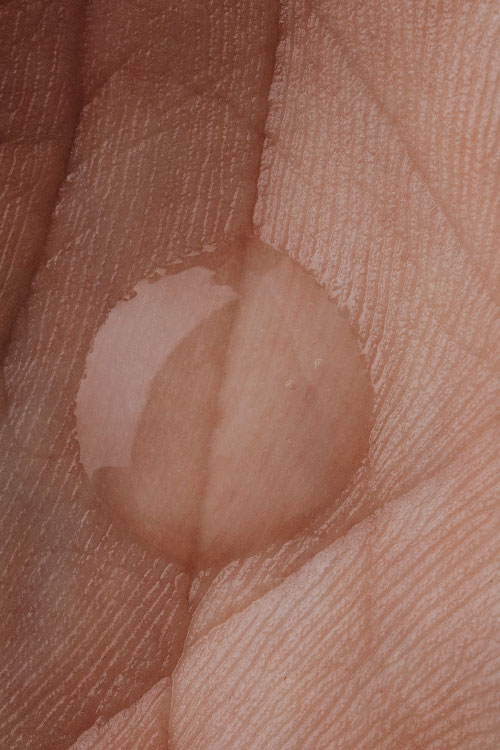10 Ingredients to Watch Out For in Moisturizers for Sensitive Skin
03 March 2021
819 views
According to a study by David Suzuki Foundation in Canada, over 80% of all cosmetic products have been found to be using one or more ingredients designated as “Dirty Dozen” potential irritants or toxicants. These ingredients are said to cause irritations or, worse, do harm to our body.
If you happen to have sensitive skin, you must be more careful to check the ingredients used to produce skin products. You must already know a few ingredients that can cause trouble on your skin, even if it can be perfectly fine on other people’s skin.

This is a list of the 10 ingredients you can commonly find in moisturizers, but recommended to avoid if you have sensitive skin, or any form of skin diseases caused by a compromised skin barrier.
- Fragrances: Many fragrance ingredients are irritants and can trigger allergies, migraines and asthma symptoms.
- Colorants: Many artificial colors are made using coal tar, petroleum or heavy metals salts like arsenic and lead. When absorbed on our skin, artificial colors can increase the risk of irritation, blocked pores, breakouts and sensitivity.
- Ethanol: Used as preservatives or solvents. It has a tendency to make your skin dry. Some experts even think that regular exposure to alcohol damages your skin barrier and causes inflammation, though it's a debated opinion.
- Parabens: Used as preservatives. Parabens easily penetrate the skin and are suspected by some researches of interfering with hormone function (endocrine disruption).
- Phenoxyethanol: Again, used mostly as preservatives. It is known to be a soft and gentle ingredient. Skin exposure to phenoxyethanol has been linked to allergic reactions ranging from eczema and hives to anaphylaxis.
- Mineral oil: Used as a moisturizing agent due to its occlusive character (i.e., prevents moisture on the skin from evaporating into air). Petrolatum can be contaminated with polycyclic aromatic hydrocarbons (PAHs) and studies suggest that exposure to PAHs – including skin contact over extended periods of time – is associated with cancer.
- PEGs: Mostly used as a solvent (that means it helps to mix oily ingredients with watery ones). Depending on manufacturing processes, PEGs may be contaminated with measurable amounts of 1,4- dioxane. The International Agency for Research on Cancer classifies 1,4-dioxane as a possible human carcinogen, and it is also persistent.
- BHT: Again, this is used as a preservative. BHA (butylated hydroxyanisole) and BHT (butylated hydroxytoluene) can induce allergic reactions in the skin.
- Benzyl alcohol: A preservative. In high amounts, it can be a skin irritant.
- Triethanolamine: Used to control a product’s PH. When combined with N-nitrogenating agents (e.g.: preservatives like 2-Bromo-2-Nitropropane-1,3-Diol, 5-Bromo-5-Nitro- 1,3-Dioxane or sodium nitrate) it can form some carcinogenic stuff (i.e., having potential to cause cancer).
One thing you might want to take note is, even among researchers, opinions differ widely according to their philosophy and approach. Those discounting the risks say research to prove the toxicity of an ingredient is most commonly done through animal studies where applied amounts far exceed the level used by cosmetic products. They also claim applying an ingredient on the skin is far safer than eating or injecting it into the body (methods most experiments use).
Still, conservatives think the cumulative impact from potentially toxic ingredients can be significant over the long term across multiple modes of applications. We can’t measure how much of a specific toxic ingredient we are exposed to (cosmetic products do not tell you how much of a specific ingredient is used for a formula), and it is possible that we could have been exposed to the same toxic ingredient from multiple different products.
According to where you stand, you will come to a completely different conclusion on whether or not to hit the "Proceed" button on your online cart screen.
Comments
Other Articles
- How Emirates Smiles challenges Invisalign in Dubai - 17 March 2023
- Top Do's and Dont's for Patient Referrals - 07 March 2022
- Express Quote Tutorial - 16 February 2022
- Best Ayurvedic Treatments in Dubai - 18 November 2021
- Best IVF Clinics in Dubai Reviewed - 02 November 2021
- LASIK: The Best Treatments and Prices in Dubai - 29 October 2021
- Vaginal Rejuvenation Treatments in Dubai: A Complete Guide - 26 October 2021
- Best Cataract Doctors in Dubai - 26 October 2021
- Best Glaucoma Doctors in Dubai - 25 October 2021
- Vaginoplasty Prices in Dubai - 24 October 2021
- Labiaplasty Prices in Dubai - 22 October 2021
- Best Varicose Vein Surgeons in Dubai - 17 October 2021
- Hair Transplant Surgery vs Non Surgical Hair Loss Treatments in Dubai - 14 October 2021
- FUE vs DHI vs Robotic Hair Transplant in Dubai - 13 October 2021
- Best Gynecomastia Surgeons in Dubai - 13 October 2021
- Best Beard Transplant Surgeons in Dubai - 12 October 2021
- Best Tummy Tuck Surgeons in Dubai - 11 October 2021
- Best Hair Transplant Surgeons in Dubai - 11 October 2021
- Best Body and Face Lift Surgeons in Dubai - 09 October 2021
- Best Liposuction Surgeons in Dubai - 07 October 2021
- Best Weight Loss Surgeons in Dubai - 05 October 2021
- Best Brazilian Butt Lift (BBL) Surgeons in Dubai - 05 October 2021
- Best Breast Surgeons in Dubai - 04 October 2021
- Best Rhinoplasty (Nose Job) Surgeons in Dubai - 03 October 2021
- Beauty Salons vs. Clinics: 3 Reasons to Consider Beauty Salons for Body Slimming in Dubai - 29 September 2021
- Best LPG Treatments in Dubai: Prices and Locations - 24 September 2021
- Beauty Salons vs. Clinics: Which is Better and Safer for Cosmetic Treatments in Dubai? - 24 September 2021
- CoolSculpting vs CoolTech, which one to choose in Dubai? - 22 September 2021
- Profhilo Treatment and Price in Dubai - 18 September 2021
- Stretch Mark Treatment Prices in Dubai - 16 September 2021
- Cellulite Treatment Prices in Dubai - 13 September 2021
- Hand and Foot Rejuvenation Prices in Dubai - 12 September 2021
- Body Slimming Treatment Prices in Dubai - 12 September 2021
- Facial Treatment Prices in Dubai - 07 September 2021
- Hair Loss Treatment Prices in Dubai - 02 September 2021
- PRP Prices in Dubai - 01 September 2021
- Mesotherapy Prices in Dubai - 31 August 2021
- Filler Prices in Dubai - 30 August 2021
- Botox Prices in Dubai - 28 August 2021
- Laser Hair Removal Prices in Dubai - 27 August 2021
- The Best Eczema Cream in Dubai from an Experienced Specialist Dermatologist - 27 June 2021
- Booking Appointment Requests, A New Process - 18 June 2021
- A new way to beauty is here in Dubai - 27 April 2021
- ZEROID, Korea's Number One Dermocosmetic Brand - 30 March 2021
- What is Skin Barrier and How Ceramides Work to Repair it? - 02 March 2021
- MartiDerm, A Trusted Brand for Skincare and AntiAging - 24 February 2021
- Skin Care for Sensitive Dry Skin - 07 February 2021
- Skin Care for Sensitive Dry Skin with Pigmentation Concern - 07 February 2021
- Skin Care for Sensitive Dry Skin with Wrinkles Concern - 07 February 2021
- Skin Care for Sensitive Dry Skin with Pigmentation and Wrinkles Concern - 07 February 2021
- Skin Care for Dry Skin - 07 February 2021
- Skin Care for Dry Skin with Pigmentation Concern - 07 February 2021
- Skin Care for Dry Skin with Wrinkles Concern - 07 February 2021
- Skin Care for Dry Skin with Pigmentation and Wrinkles Concern - 07 February 2021
- Skin Care for Sensitive Oily Skin - 04 February 2021
- Skin Care for Sensitive Oily Skin with Wrinkles Concern - 04 February 2021
- Skin Care for Sensitive Oily Skin with Pigmentation Concern - 04 February 2021
- Skin Care for Sensitive Oily Skin with Pigmentation and Wrinkles Concern - 04 February 2021
- Skin Care for Oily Skin - 03 February 2021
- Skin Care for Oily Skin with Wrinkles Concern - 03 February 2021
- Skin Care for Oily Skin with Pigmentation Concern - 03 February 2021
- Top 5 Moisturizers Recommended in Dubai for Atopic Dermatitis or Extremely Dry and Sensitive Skin - 31 January 2021
- Skin Care for Oily Skin with Pigmentation and Wrinkles Concern - 13 January 2021
- The Future of Healthcare Services is at Home - 08 January 2021
- Dermatologists' Guide to Select Right Cosmetic Products - 30 December 2020
- Pfizer Vs Sinopharm in the UAE: Which COVID Vaccine Should I Take? - 24 December 2020
- The Most Comprehensive Business Tool for Hospitals and Clinics - 21 October 2020
- Top 5 Most Popular Dental Treatments on DrFive - 29 June 2020
- Welcome to UAE’s #1 Healthcare Review Portal - 29 June 2020
- Top 3 Dental Clinics by Volume of Vouchers Sold on DrFive - 28 June 2020
- Did You Know that Dental Patient Referral by DrFive is 5 Times Better than Google? - 25 June 2020
- Did You Know 89% of Patients in Dubai are Happy with their Doctors - 24 June 2020
- Did You Know Over 50,000 People Visit Doctor Profiles Every Month - 23 June 2020
- Did You Know Patients Trust Reviews - 22 June 2020
- COVID-19 in Pregnancy - 07 April 2020
- Top 10 Gynecologists in Dubai by Reviews in 2019 - 15 January 2020
- Best Orthopedic Hospital in Pusan: Kang Dong Hospital - 15 January 2020
- Top 10 Dermatologists in Dubai for 2019 - 07 January 2020
- Top 8 Plastic Surgeons in Dubai for 2019 - 05 January 2020
- Top 10 Orthopedic Surgeons in Dubai for 2019 - 05 January 2020
- Best General Hospital in Pusan: Pusan National University Hospital - 29 December 2019
- 5 Essential Medical Tests for Men Over 40 in Dubai - 08 December 2019
- Compare Dental Services in Dubai with ExpressQuote - 16 September 2019
- Korea's Top Surgeons Obsessed with Safety - Banobagi Plastic Surgery - 25 June 2019
- Gold Standard in Korea? - JK Plastic Surgery - 19 May 2019
- Treating Back Pain Without Surgery – Jaseng Hospital - 12 May 2019
- Ginseng, the Elixir of Life? - 12 May 2019
- First and Best Infertility Treatment in Korea - MizMedi Hospital - 01 May 2019
- The Only Heart Specialty Hospital in Korea - Sejong Hospital - 01 May 2019
- Why Arab Patients Choose Wooridul? - 01 May 2019
- Intro: Best Hospitals in Korea 2019 - 18 April 2019
- Dubai: FREE CME Points for OB/GYNs on March 11 - 09 March 2019
- Top 10 Dubai Rheumatologists Most Searched in 2018 - 18 January 2019
- Top 10 Gynecologists in Dubai by reviews in 2018 - 18 January 2019
- Dubai: FREE CME Seminar for OB/GYNs on January 22 - 17 January 2019
- Top 10 Pediatricians in Dubai by reviews in 2018 - 16 January 2019
- Top Doctor Reviews of the Week, Dec 20 - Dec 27, 2018 - 27 December 2018
- Top Doctor Reviews of the Week, Dec 14 - Dec 20, 2018 - 21 December 2018
- Top Doctor Reviews of the Week, Dec 7 - Dec 13, 2018 - 13 December 2018
- Top Doctor Reviews of the Week, Nov 30 - Dec 6, 2018 - 06 December 2018
- Who is the most recommended Dubai gynecologist at each hospital in 2018? - 05 December 2018
- Top Doctor Reviews of the Week, Nov 23-29, 2018 - 29 November 2018
- Top Doctor Reviews of the Week, Nov 15-22, 2018 - 22 November 2018
- Top 4 complaints to doctors in Dubai - 15 November 2018
- Top Doctor Reviews of the Week, Nov 8-14, 2018 - 15 November 2018
- Top 5 Patient Complaints to Healthcare Management in Dubai - 14 November 2018
- New Features on DrFive Exclusively for Doctors - 11 November 2018
- Top Doctor Reviews of the Week, Nov 1-7, 2018 - 08 November 2018
- 3 Important Health and Behavioral Takeaways from Ramadan for Non-Muslims Living in Dubai - 18 June 2018
- Why is Your Child Sick in Dubai? - 28 May 2018
- Inhaling Dust in the UAE: Will it Take Your Breath Away? - 20 May 2018
- Top 6 Neurologists in Dubai by Search Volume - 13 May 2018
- My Daughter Started her Period: Too Delicate a Topic in the UAE? - 03 May 2018
- The Real Price of a Hollywood Smile - 08 April 2018
- Meet the 1st Artificial Intelligence (AI) Doctor for Stroke Diagnosis - 23 February 2018
- Top 8 Endocrinologists in Dubai by Search Volume - 20 February 2018
- Top 7 Gastroenterologists in Dubai by Search Volume - 17 February 2018
- Top 7 Internal Medicine Doctors in Dubai by Search Volume - 14 February 2018
- Dubai's 10 Most Popular Psychiatrists in Feb 2018 - 11 February 2018
- Top 7 ENT Doctors in Dubai by Search Volume - 06 February 2018
- Top 7 Urologists in Dubai by Search Volume - 06 February 2018
- Top 10 Pediatric Dentists in Dubai by reviews Jan 2018 - 04 February 2018
- Top 7 Plastic Surgeons in Dubai by Search Volume - 01 February 2018
- 10 Dental Clinics in Dubai with Reasonable Prices - 16 January 2018
- Top 9 Chiropractors in Dubai by reviews in 2017 - 11 January 2018
- Top 5 Pediatricians in Dubai by reviews in 2017 - 03 January 2018
- Top 6 Orthopedic Surgeons in Dubai by reviews in 2017 - 03 January 2018
- Top 5 Ophthalmologists (Eye Doctors) in Dubai by reviews in 2017 - 02 January 2018
- Top 5 Dermatologists in Dubai by reviews in 2017 - 31 December 2017
- Top 9 Dentists in Dubai by reviews in 2017 - 29 December 2017
- Top 10 Gynecologists in Dubai by reviews in 2017 - 29 December 2017
- Korea, the best Healthcare in the World? - 20 October 2017
- Meet Top Korean Hospitals and Clinics in Dubai: Korea Medical and Wellness Travel Mart - 11 September 2017
- New Day, Same Ugly Face! - 07 June 2017
- Brain Eats Itself: a new finding on sleep deprivation - 30 May 2017
- DrFive presents: La Familia Medical Center - 25 May 2017
- Even moderate drinking increases risk of breast cancer - 24 May 2017
- Instagram the Worst for Young People's Mental Health - 23 May 2017
- Why visit, when you can just make a call for medical consultation? - 22 May 2017
- Hackers Seize Patient Information With Ransomware and Extort Hospitals - 17 May 2017
- 5 Tips for Healthy Teeth: Dr May - Talass Medical and Dental Center - 14 May 2017
- Union Coop pulls Sadia frozen chicken off Dubai shelves - 14 May 2017
- Bridge-Enhanced ACL Repair (BEAR) | Boston Children's Hospital - 11 May 2017
- Medical Tourism in Bangkok Thailand - 10 May 2017
- You Can Take Steps to Lower Your Breast Cancer Risk - 09 May 2017
- Popular Indian doctor in UAE dies of lung cancer - 08 May 2017
- 3D printing plastic braces for $60 - 08 May 2017
- Children's Hospital of Philadelphia 'artificial womb' life-changer for premature babies - 07 May 2017
- DrFive review: Prime Hospital - 13 December 2016
- Dubai’s Most Mentioned Hospitals: Sick on Friday, What is Your Best Option? - 08 November 2016
- Pediatric Care: Where Should I Go? - 18 October 2016
- American Hospital vs Mediclinic City Hospital - 20 September 2016




Enter your comment below
Press 'ENTER' key to submit